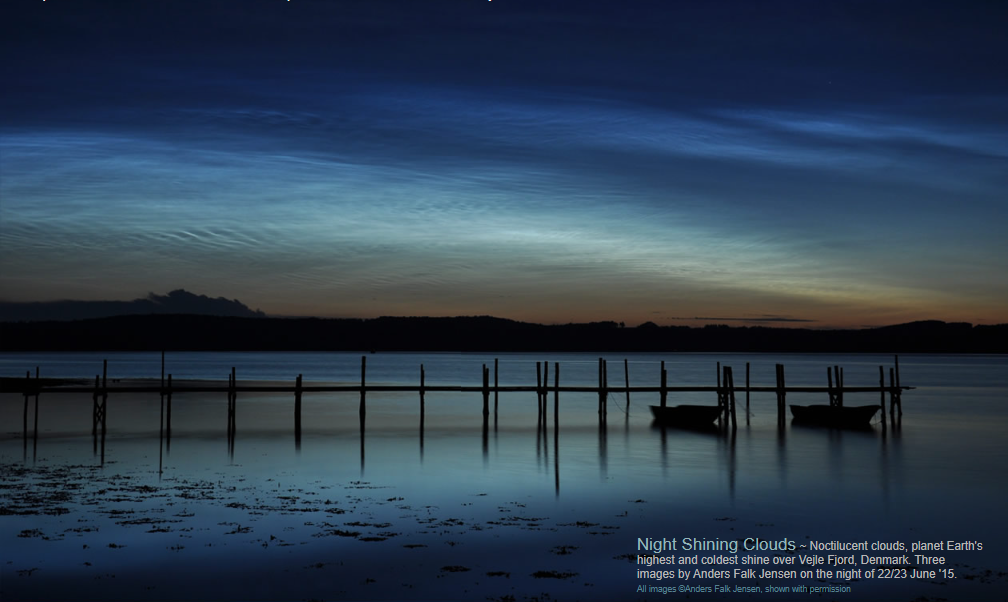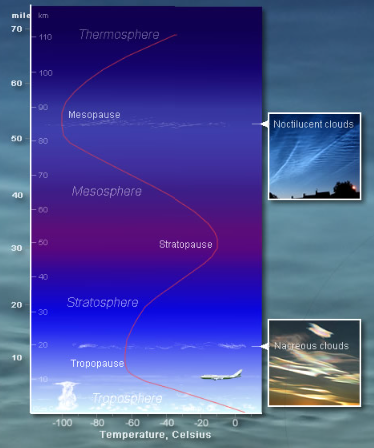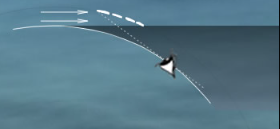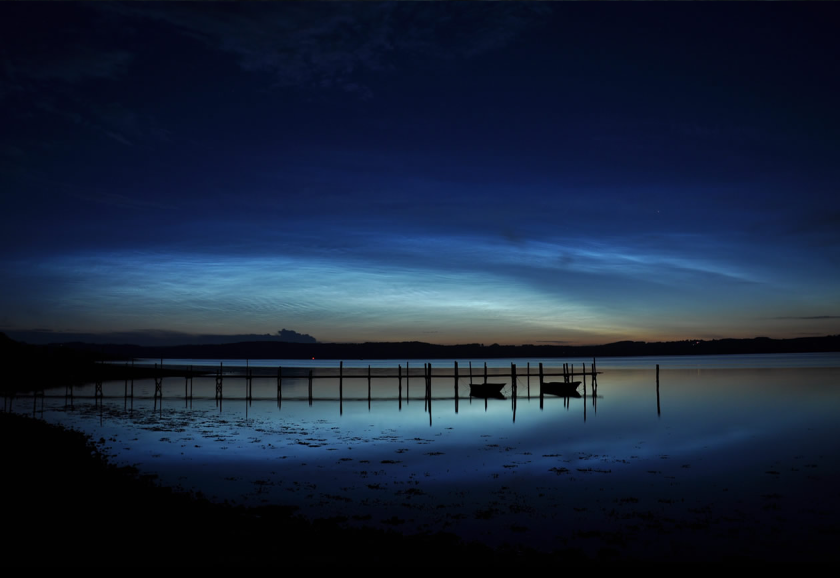Noctilucent Clouds, Denmark - OPOD
Noctilucent Clouds: A Mesmerizing Display in Denmark
Noctilucent clouds, also known as night shining clouds, are a captivating atmospheric phenomenon that occurs at the highest and coldest regions of Earth's atmosphere. In this article, we will delve into the mesmerizing world of Noctilucent clouds, focusing on a particular sighting over Vejle Fjord, Denmark, captured by photographer Anders Falk Jensen on the night of June 22-23, 2015.
The Enigmatic Nature of Noctilucent Clouds
Noctilucent clouds reside at an astounding altitude of 80-85 kilometers (50-53 miles) above the Earth's surface. Composed of tiny ice crystals measuring only 0.1 micron in size, these ethereal formations require extremely low temperatures below -123 degrees Celsius (-189 degrees Fahrenheit) to come into existence. Such frigid conditions are found in the dry mesosphere, the layer of the atmosphere located above the troposphere and stratosphere.
The Role of Nuclei in Noctilucent Cloud Formation
To form these delicate ice crystals, Noctilucent clouds rely on the presence of nuclei upon which they can grow. Various particles serve as potential nuclei, including meteor dust, lofted oceanic salt, volcanic ash, and even rocket exhausts. These minute particles provide a foundation for the ice crystals to develop and flourish, contributing to the formation of these awe-inspiring nocturnal displays.
Increasing Frequency and Paradoxical Climate Effects
In recent years, there have been indications that Noctilucent clouds are becoming more frequent. This paradoxical trend can be attributed to the warming of the lower atmosphere, which leads to a cooling effect in the mesosphere where these clouds reside. As global temperatures rise, the cooling of the mesosphere creates an environment conducive to the formation of Noctilucent clouds, resulting in their potential increase in occurrence.
Optimal Viewing Conditions
To witness the enchanting beauty of Noctilucent clouds, one should seek them out during the summer months. Look towards the northern horizon, particularly in the northern hemisphere, approximately an hour after sunset. It is essential to choose moonless nights for optimal viewing, as the moon's illumination can hinder the visibility of these delicate formations.
Distinguishing Noctilucent Clouds
Differentiating Noctilucent clouds from lower tropospheric clouds can be accomplished by observing their unique characteristics. By utilizing binoculars, one can discern the shifting skein-like appearance of Noctilucent clouds, setting them apart from their lower-altitude counterparts. This distinctive visual trait adds to the allure and mystique of these ethereal formations.
Illumination and Stratospheric Ozone
The radiance of Noctilucent clouds stems from their high altitude positioning, which allows them to remain illuminated by sunlight even during the night. Stratospheric ozone plays a role in their appearance, as it absorbs some of the scattered light, resulting in a bluish hue. This interaction between the clouds and atmospheric components adds a touch of enchantment to their already captivating presence.
In conclusion, Noctilucent clouds offer a mesmerizing spectacle that enchants viewers around the world. Their formation at extreme altitudes and frigid temperatures, coupled with the interplay between light and atmospheric elements, creates a captivating display in the night sky. The sighting over Vejle Fjord, Denmark, captured by Anders Falk Jensen, serves as a reminder of the mysterious beauty that can be found within our atmosphere. So, keep your eyes on the northern horizon during summer nights and embrace the opportunity to witness the enchantment of Noctilucent clouds.

Night Shining Clouds ~ Noctilucent clouds, planet Earth's highest and coldest shine over Vejle Fjord, Denmark. Three images by Anders Falk Jensen on the night of 22/23 June '15.
All images ©Anders Falk Jensen, shown with permission

Noctilucent clouds are 80-85 km (50 – 53 mile) high.
Small, 0.1 micron, ice crystals compose them. Very low temperatures below -123 Celsius are needed to form ice in the dry mesosphere.
Nuclei on which the ice crystals can grow are also needed. Meteor dust, lofted oceanic salt, volcanic ash and rocket exhausts are all candidates.

NLCs are possibly becoming more frequent. Paradoxically, as the lower atmosphere warms the mesosphere cools.
Look for NLCs in summer. Look to the north (northern hemisphere!) an hour or so after sunset.
Avoid moonlit nights.
Use binoculars where their shifting skein like appearance distinguishes them from lower tropospheric clouds.
NLCs shine because at their high altitude they are still in daylight.
Stratospheric ozone absorbs some of their scattered light to confer a blueish colour


Note: this article has been automatically converted from the old site and may not appear as intended. You can find the original article here.
Reference Atmospheric Optics
If you use any of the definitions, information, or data presented on Atmospheric Optics, please copy the link or reference below to properly credit us as the reference source. Thank you!
-
<a href="https://atoptics.co.uk/blog/noctilucent-clouds-denmark-opod/">Noctilucent Clouds, Denmark - OPOD</a>
-
"Noctilucent Clouds, Denmark - OPOD". Atmospheric Optics. Accessed on November 26, 2024. https://atoptics.co.uk/blog/noctilucent-clouds-denmark-opod/.
-
"Noctilucent Clouds, Denmark - OPOD". Atmospheric Optics, https://atoptics.co.uk/blog/noctilucent-clouds-denmark-opod/. Accessed 26 November, 2024
-
Noctilucent Clouds, Denmark - OPOD. Atmospheric Optics. Retrieved from https://atoptics.co.uk/blog/noctilucent-clouds-denmark-opod/.